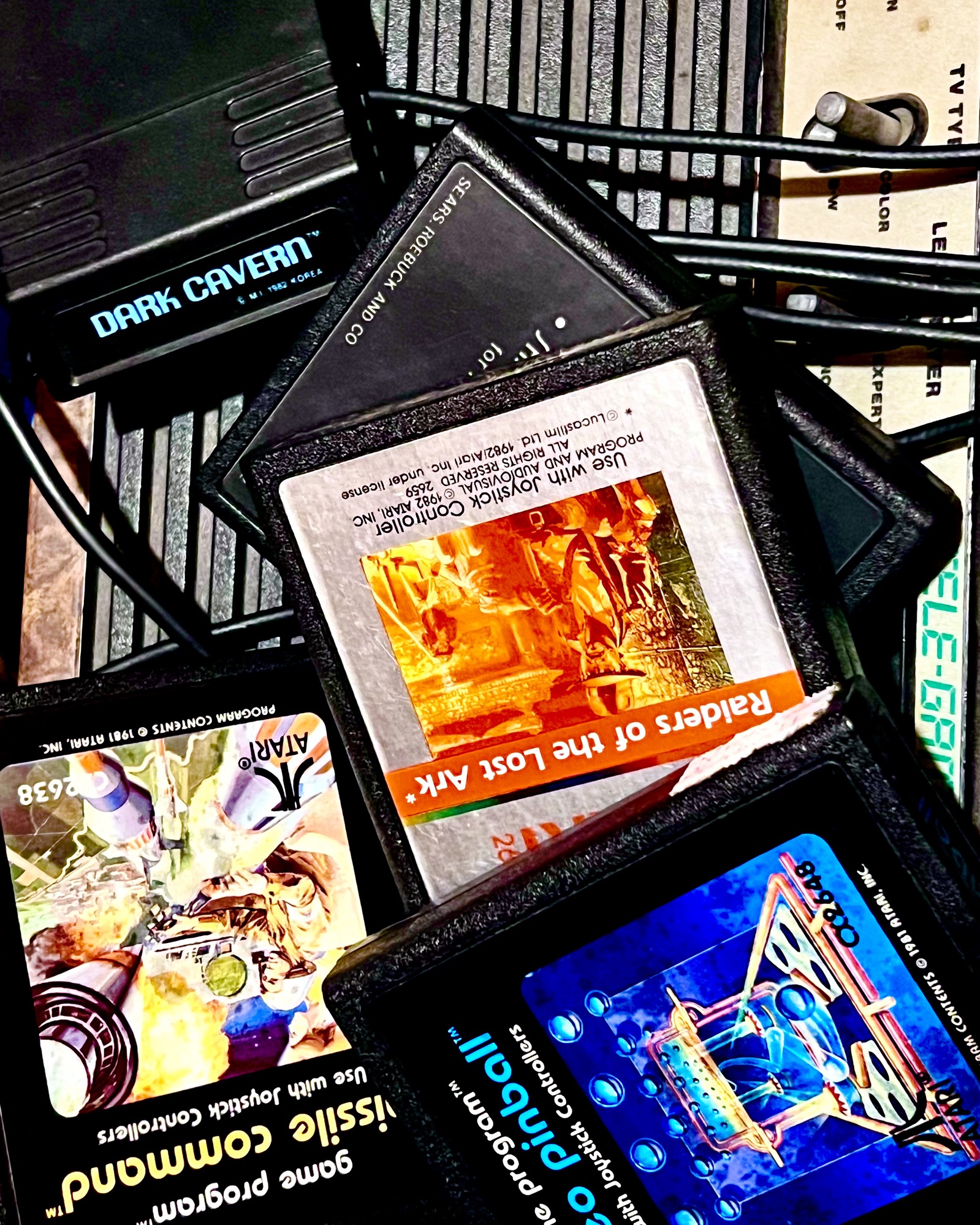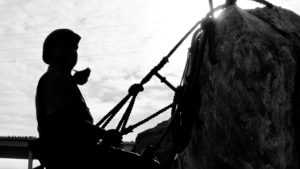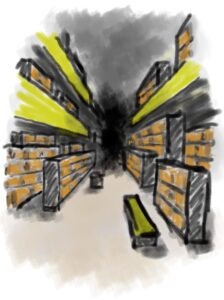Read Part 1 here
Read Part 2 here
Souk Baijin took a deep breath, then flipped a switch and entered a series of commands into the pilot’s console of the weathered scavenger ship. His display illuminated, though most of the other controls around the crew compartment remained dark.
A status indicator spun in the middle of the screen as the ship received data from the squadron of tiny drones scattered throughout the nearby canyon. A moment later, a three-dimensional map appeared, their current location indicated by a bright triangle, with a separate glowing trail tracing its way across the image. They flew right by us, he realized, and the hair stood up on the back of his head. The trail continued on straight for some distance, then ascended, made several loops around the area, and finally rose back up above the clouds and into space.
The pilot zoomed out as far as he could go, until even the curvature of the planet was visible. He traced the line far above the surface, where the luminous path ended in a blinking dot. Zooming back in, a text bubble appeared, anchored by a thin line to the terminus. “CONTACT LOST,” it read in bold type.
Charle Sage had made his way back from his review of the small plastic silver-speckled cartridge that made up the entirety of the cargo in the hold. Now he stood behind Baijin, looking at the pilot’s display. “Gone?”
Baijin nodded. “It worked. They couldn’t find us. Looks like they jumped out.”
“Didn’t even stay for a souvenir.” Some of the navigator’s earlier anxiety now turned to bravado, and he smiled.
The pilot smiled back. “Like you said, not much left at this point, other than rocks and ashes.”
“Anybody else come to visit in the meantime?”
Baijin zoomed back out as far as he could and panned across the field of view. “No, just us, at least within scanning range.”
Sage went back to his seat and buckled in. “Then let’s go see if there’s anything worth seeing.”
The ship hummed back to life as various systems powered on. One by one, they performed the many checks and diagnostics needed for safe operation of any interstellar vessel after a shutdown, and they prepared to resume their original mission.
Engines rumbled and they rose from their hiding spot, dust cascading back to the rocky ground like a cloud of flour in a bakery. Before a minute had passed, they were up over the canyon and Sage was back to scanning his display; he had highlighted a small area some kilometers away, and he zoomed in. On Baijin’s screen, a triangular icon representing their location moved across the screen, tracing their progress towards the navigator’s target.
“Cha? You need a landmark, or…”
“I’ve got it,” Sage replied.
Baijin turned back to his controls, letting his colleague work in silence. The atmosphere in the ship was tense, but it was a different kind of tension than before. This was no longer fear of confrontation; it was apprehension mixed with cautious optimism about the subject of their search. Despite his earlier convictions, there was still a chance that there was no hidden cache in the first place, and an equal chance that it had not remained hidden over the long centuries. He wondered which would be more disappointing.
The landscape changed little as they flew; brown and tan still dominated the color palette. The terrain was rugged, alternating between craggy canyon lands and dusty plains; parcels of land were partitioned by dry riverbeds and punctuated by mountain peaks.
Here and there were signs of a long-past civilization. Structures and vehicles had long since returned to their base components, but their shadows remained. Piles of rubble at regular intervals suggested the grid patterns of city streets. Long, flat tracks that sometimes cut through the mountains in obvious lines might have been highways once. And those same dry rivers and canyons occasionally sported patterns of dots that might once have been the piers of bridges.
Then, the country changed from dusty brown to bright, snowy white as they crossed what looked like billowing dunes of powder. Some kind of salt flats, Baijin thought. A moment later, white changed back to brown and he heard a pleasant chime from the direction of Sage’s console. They were at their destination.
There might have been a hill there, once—a landfill, they called it, a literal hill made of trash—but it looked as though it had long since been cleared of anything of the slightest value. It was more of a crater now, strewn with scraps of debris and blowing dust.
Baijin looked out the small viewport. “Well, that’s not promising.”
“Just keep us up here while I look,” Sage said. A highlighted border had appeared on his display, encircling a large region around the ship and the crater. He was squinting hard now, looking at a series of lines in different colors as they danced across the screen, searching for a telltale pattern. He didn’t see it.
Frowning, he shifted his view away from the crater and started scanning around the periphery, to flat patches of land that looked undisturbed and inconsequential. For what seemed like an age, the same set of patterns repeated. Then, a hint of something new; he narrowed his view and the pattern became clearer and more pronounced. He stared, not daring to breathe, but the pattern kept repeating as he swept the pointer back and forth. The highlighted perimeter contracted to a small and well-defined blob of pulsing color.
“I think I found it,” he said softly. “Souk?”
Baijin was quiet. “Ok,” he said finally, and entered some commands. For the second time that day, the landing skids extended and the ship gently eased to the ground, landing in a plot of crushed gray stone that was pitted with potholes.
The two made their way back into the cargo hold. The atmosphere outside was breathable, but they still pulled on pressure suits and helmets with respirators, then reinforced work gloves and boots with tight-fitting seals. No sense risking exposure to some long-forgotten bacteria or virus, or to something new—and maybe worse.
The inner airlock door hissed softly as it swung back and away, and they stepped inside. Both held their hands up in front of their helmets, confirming that all limbs were clear of moving parts, then Baijin pressed a button and the door slid back into place.
The space held a workbench with a number of tools, and small shelves filled with boxes of equipment lined the walls. Baijin walked past all this to a panel at the other end and fiddled with a lever, and a moment later there was a louder hiss. An outer door opened, swung outward on thick metal hinges, and lowered to the surface, forming a sort of ramp. Sage walked to the side of the airlock and picked up a small device with a screen and a short rectangular antenna. Bending down, he flipped a switch and turned a key on a small wagon-like apparatus, which unfolded with a whirring noise.
“Thanks for choosing the Indy Pro EX 304. Startup sequence initiated,” said a mechanical voice in their headsets. Wheels began to turn and the machine—a mobile excavator—rolled down the ramp ahead of them. “For operator safety, keep hands and feet clear at all times and follow all instructions…”
“Ready?” Sage asked.
“Let’s go,” Baijin replied. They walked down the ramp and stepped out into the surface.
The excavator led them across the stones and earth, bumping and swaying through a maze of pits and rubble. As they walked, Sage watched the screen of the device he carried, which showed a 3D representation of the terrain, their locations, and a softly glowing area about 15 meters away, then 10, then 5, and finally underfoot. They stopped. All attention was fixed on the ground.
Baijin had brought a small implement with a brush and shovel from the cargo hold. He stood aside, waiting. Sage entered a series of commands and various implements extended from the excavator.
“Excavation beginning. Clearing designated area in exploratory mode. Please stay behind safety boundary.” The machine projected a red line on the ground—the safety perimeter—then began to scrape aside the upper layers of soil, pushing dirt and debris into a rough pile.
It dug. Half a meter down, nothing, then a full meter. Still nothing.
Another fraction of a meter. It stopped. The display lit up, a light flashed, and the excavator backed away. Sage and Baijin cautiously moved forward. They looked into a wide opening in the ground, broad enough for the two of them and then some, and almost as long.
Without a word, the pilot gingerly lowered himself into the hole. With the brush, he gently swept away a thin layer of remaining dust. Something gleamed in the shadows at the bottom of the pit. With the tip of the shovel, he freed the object from its resting place. He held it up so Sage could see.
It was a small, dark rectangle, pockmarked with silver hemispheres of varying sizes, some as large as a fingernail. The navigator held out his hand; the pilot gave him the object. With a small metal implement, Sage carefully pried off one of the dry silver droplets and placed it in an opening on the top of the excavator.
“Analyzing sample,” the machine said. The compartment slid closed.
Sage looked down at the block of plastic still in his gloved hand. Unlike the specimen back on the ship, this one had its ancient paper label still attached. Though faded and torn at the edges, he could make out an image of a human child’s head, next to a wrinkled face with large, expressive eyes. Meant to be an alien, I suppose, he thought.
“Can you read Old English?” Sage asked.
“A little. Can’t make out more than a couple of characters. ‘E’ and ‘T’, I think.”
“That mean anything?”
He shook his head. “Not to me.”
Baijin looked down at his feet and at the earth, frowned, then bent over. He could see the corner of some other object buried in the ground. He brushed away more dirt as Sage looked on. As he did, the outline of another plastic rectangle became clear, then, next to it, another, then another. He lifted one and saw part of yet another underneath.
Sage paused long enough to carefully put down the ancient relic he still held, then jumped down next to his partner. With his bare hands, he scooped up loose earth and hurled it out of their way as Baijin exposed dozens, maybe hundreds, of the strange artifacts; they spread across the entire bottom of the hole, stacked on top of one another all the way to the edges of their small excavation, perhaps beyond.
The condition of the game cartridges varied. Some had been broken or smashed; many were missing labels in whole or in part. Who knew the reason why they were all buried here, separated from the rest of the trash, or why they had made so many in the first place, only to throw them away? All that mattered was that they were here, and that every one was speckled with silver. Silver that should be…
A chime sounded in their helmets. “Analysis complete. Sample comprised of nullium and additional trace elements. Nullium content approximately 97.87 percent.”
Sage stopped scooping and Baijin stopped digging. They looked at each other. The wind blew, briefly swirling the dust into a miniature cyclone, then stopped. All was calm.
“I don’t know what ‘ET’ meant to these people,” Baijin said, after a long moment. “But I think it means we’re rich.”
THE END…for now…



